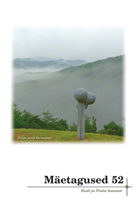Jehoova tunnistajad Eestis
Jehovah’s Witnesses in Estonia
Author(s): Ringo RingveeSubject(s): Customs / Folklore
Published by: Eesti Kirjandusmuuseum
Keywords: Jehovah’s Witnesses; Watchtower Bible and Tract Society; religion; new religions
Summary/Abstract: The article explores the history of the Watchtower Bible and Tract Society in Estonia. The first Bible students emerged in Estonia in the 1920s, and the Society started its work in the country in 1926 when the local office was opened. In 1935 the Watchtower Society was closed down according to the Emergency Act. The Society was accused of activities that caused social unrest and damaged the interests of Estonian foreign policy. The Jehovah’s Witnesses, however, although banned as an organization, continued their work in spreading the Biblical message around the country. In 1940 Estonia was incorporated into the Soviet Union. The foreign staff of the Watchtower Society left the country and from there on the Estonian Jehovah’s Witnesses organized their work on their own, and their contacts with the headquarters abroad were lost. Although from 1941 to 1944 Estonia was occupied by German military forces, little action was taken against the Jehovah’s Witnesses. The Soviet authorities’ repressions against them started in 1948 when the leading Jehovah’s Witnesses were arrested and sent to prison camps. In 1951 during the operation Sever (North) carried out by the Soviet authorities, which targeted the Jehovah’s Witnesses in the new territories of the Soviet Union, almost all Witnesses were deported from Estonia to Tomsk region in Siberia. All of the Estonian Jehovah’s Witnesses were gradually released by the mid-1960s. However, the Soviet anti-religious campaign targeted the Jehovah’s Witnesses, stigmatizing them in the media and at their workplaces. By the late 1960s the Witnesses in Estonia had established their contacts with their headquarters in the West and started organizing the Watchtower Society’s work in the Baltic countries as well as in the western part of the Russian Soviet Federative Socialist Republic, including Leningrad (St. Petersburg). Although the direct repressions against Jehovah’s Witnesses during the Soviet period in Estonia were rare compared to other Soviet republics, the authorities monitored them, and conscientious objectors were imprisoned. When the Soviet regime ended in Estonia in 1991, the Jehovah’s Witnesses registered their religious organization and started their missionary activities. In the 1990s there were several conflicts between the mainstream society and the Witnesses. The conflicts included conscientious objectors, blood-free medicine, the use of rented facilities for their religious services, and sensational but unsubstantiated news by the tabloid media. However, by the 2000s the problems were solved, and in a short time the Jehovah’s Witnesses had become the fourth or fifth largest denomination in Estonia.
Journal: Mäetagused. Hüperajakiri
- Issue Year: 2012
- Issue No: 52
- Page Range: 161-176
- Page Count: 16
- Language: Estonian

